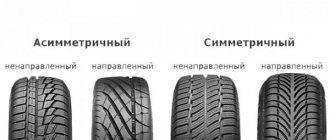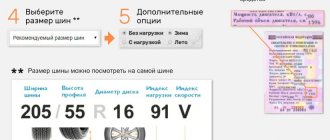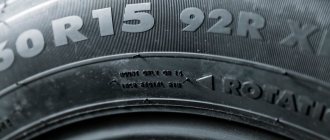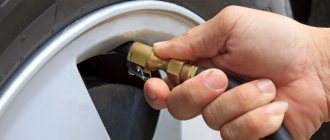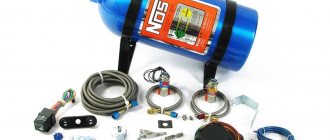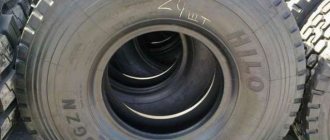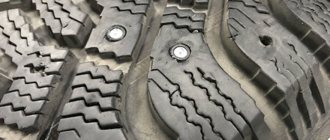- Laws of physics
- What to do to avoid tire pressure surges?
Properly inflated tires are the key to the safety of the driver and his passengers. Experts advise measuring the number of atmospheres a few hours before the trip - at a time when the tires are cold. However, many motorists, having inflated their tires as required, soon notice a change in the hardness of the tires. If the pressure rises, it starts to hit the steering wheel at speed; if it drops, the car becomes more difficult to control. Why is this happening?
The consequences of driving on worn tires
They can be quite disastrous and very costly. The main negative factor is poor road grip. Because of this, the ability to properly control the car is significantly reduced; the vehicle may not fit into a turn, and even fly out of its lane into a ditch or into the oncoming lane.
The second type of risk lies in the constant threat of a thin tire bursting even with minimal vehicle load. This situation can lead to complete loss of control and a terrible head-on accident.
Also, do not forget that worn tires sometimes cause increased fuel consumption and worsen the aesthetic appearance of the iron horse. By the condition of the wheels, you can safely judge the technical maintenance of the vehicle, and as a result, the attention and care of the owner.
Why you can’t leave your car with the wheels turned all the way
Why experienced drivers practice such twisting is also no secret. In the event of an accident (for example, if another car drives into a parked car from behind), turning the wheels toward the curb is practiced as an insurance policy because if the car starts moving involuntarily, it will simply hit the curb with its front wheels.
Some car enthusiasts are also convinced that a car with its wheels turned out is thereby protected from tow trucks (in fact, this is a misconception).
Meanwhile, there is a strong opinion that in some cases leaving a car in a parking lot with the wheels turned all the way is wrong and even dangerous. Let's see if this is true.
Indeed, in some cases, twisting the steering wheel to a large angle for a long time is undesirable, especially when the power unit is running. This applies to the greatest extent to models equipped with power steering. After all, if the wheels are turned to the maximum and the power unit is running, the power steering (or rather its rotary pump) will be under increased load due to increased oil pressure in the system. This is fraught with failure of the unit.
In addition, even with the ignition off, it is undesirable to turn the power steering wheel to the maximum. Yes, when the car is not started, the pumps and other power steering components are not under load. However, the next time you start the engine of a car left with the wheels turned out, an increased load will immediately be placed on the power steering. By the way, this is also indicated by increased engine speed. Therefore, it is no coincidence that the manuals for many vehicles specify that holding the steering wheel in the extreme position for more than 15 seconds is not recommended.
In addition, if the oil pipes of cars with hydraulic booster are old or damaged, if the steering wheel is held at a large angle for a long time, they may burst or crack due to tension.
It is also true that when parking like this in winter, additional load falls on the anthers of the constant velocity joints of the wheels (CV joints). The rubber simply stretches and loses its elasticity. Over time, it may burst or crack, and then dirt will get inside the boot, causing damage to the suspension elements. Thus, owners of cars with power steering should develop the habit of not turning the steering wheel at a large angle for a long time, especially if the car is old.
On the other hand, for cars with electric power assistance, parking cars with their wheels turned out is not prohibited. As is known, if in a classic power steering the force is created by pumping up pressure in the system, then in the electric power steering the rotation is carried out due to the operation of an electric motor.
This solution relieves the EUR from increased loads when the steering wheel is turned to the maximum. However, it does not protect the constant velocity joint boots from excessive tension. Hence the conclusion - do not leave your car (even if it is equipped with electric power steering) for a long time with the wheels turned all the way, especially in winter, especially if the car is not new and the rubber steering elements have already lost their former elasticity.
Consequences of using tires with old, but not completely worn out tread
Almost similar to the above factors. However, many car owners, observing at least a slight relief on the tires, or using old tires that have been lying in the garage for many years, believe that they can delay replacement and wait for maximum wear, or a seasonal change.
It is also very popular among domestic motorists to purchase used tires, swap wheels, and install less worn tires on the drive pair. This option postpones the mandatory purchase for a while and saves the resources of the careless owner.
However, as practice shows, the stingy pays twice. Using tires with average wear is just as dangerous as using completely bald wheels. Even on a dry road, at speeds of up to sixty kilometers per hour, the braking distance with a worn tread can be more than two meters. This means that in this case, too, it is advisable to fork out the cash and purchase a new set of tires, which can at any time become a life-saver in an unforeseen emergency situation on the road.
About the reasons leading to negative consequences
There are at least five reasons that can ruin your mood before or during a bike ride:
- Natural wear and tear on a bicycle tire.
- A foreign body has entered the tire.
- Not fully inflated.
- Over pumped.
- Special anti-puncture tape.
Let's look at each problem separately and find out what's going on.
Worn tire
Most often, a tire on a bicycle goes flat because it has served its useful life. The surface of the tire becomes more viscous, collecting various debris, small glass, and so on. All the little things gradually penetrate inside, right up to the chamber. The result is another puncture.
In addition, worn-out tires form holes into which the bicycle tube can be seen when inflated. It may simply come into contact with the road while moving. This will inevitably lead to another unpleasant situation.
Foreign body in the tire
We sealed the camera after the puncture using flipper tape, but the working element still constantly deflates. Perhaps there was a piece of glass left in the tire. It is difficult to detect and constantly causes problems for the cyclist.
On a note! Before beading, carefully check the wheel for small stones, glass and other foreign debris.
When beading and dismantling a wheel, you need to use a special tool - a beading blade. Avoid screwdrivers, wrenches, etc.
The element is not fully inflated
In this case, there is not enough shock absorption. You can get a puncture by running into, for example, a pointed hole.
The working element has been pumped
Another reason why a bicycle tire gets flat. The inside of the rim is glued with flipper tape. She is the one who protects the camera. An overinflated element may tear the flipper or burst.
Tape designed to prevent punctures
Indeed, protective tape can be a source of problems. It is tough, with sharp edges. If installed incorrectly, the camera can be cut.
Note! Constant use of an anti-puncture tube reduces tire wear resistance.
How to check the suitability of passenger car tires?
You can do this yourself using a patterned, volumetric or numerical indicator, which are installed on car tires at the manufacturer’s factory.
- Volume indicator. It is a bulge in the groove of the tread pattern. When the edges of the surface relief compare with the rubber mark, it is time to change the tire.
- Pattern indicator. It is applied in the form of figures, logos or stripes that indicate the height of the tread. The smaller their height, the longer their service life, and the sooner they will have to be replaced.
- Numerical indicator. The most informative option for determining wear. Numerical percentages starting from one hundred percent are embossed on the rubber. The number one hundred has a minimal convexity, and a comparison of the tread boundary with the last number indicates the need to urgently change old tires to new ones.
- Visual inspection. Inspect the tire from all angles. The side cord of the tire may have cracks and cuts. In this case, it is necessary to replace it with a new set of tires, since driving on country roads can cause heating and rupture of the side section of the tire, which will lead to loss of controllability and serious consequences.
As can be seen from the above, independent monitoring of tire service life is not so difficult. And if you always monitor the indicators, you can replace your wheels in a timely manner and enjoy an excellent, safe ride regardless of the time of year.
Adhere to this rule, and you will always be confident in your abilities, as well as in the complete control of the vehicle in any road situations.
Why is it undesirable to install wheels with a larger diameter than the factory ones?
Ideas on how to improve your vehicle come to every motorist from time to time.
One option is to replace the wheels with larger ones. Theoretically, this allows you to expand ground clearance, increase the speed that the car can reach to the maximum, improve traction, and therefore control of the vehicle. But not everything is so simple and wheels can only be increased according to certain rules.
Which wheels are superior to factory ones. Typically, for any car, the manufacturer offers several tire sizes to choose from. Each option first undergoes appropriate tests to confirm that they are suitable for optimal and safe operation of the vehicle. Theoretically, you can buy a car whose wheels have a diameter of 15 inches with 17-inch wheels; the former can be replaced with larger ones if the car is produced with larger rims.
If you want to change the wheels to larger ones, you should definitely check what wheel sizes are acceptable by referring to the vehicle's owner's manual. It is also important to understand that enlarging the wheels, even within the permissible limits, according to the car manufacturer, has not only advantages, but also disadvantages.
How does the damage from large disks manifest itself? Larger discs naturally mean greater weight, which increases unsprung weight. The heavier the wheel, the more difficult it is for the engine to spin it, which increases fuel consumption, worsens dynamics, and negatively affects the condition of the suspension. A larger diameter disc has a larger width and a changed seating depth in the wheel arch, which inevitably affects the functioning of the wheel bearings, or rather, leads to their premature wear.
What is the harm from large tires? Tires larger than those installed by the manufacturer are heavier, which in total leads to a further increase in unsprung weight. It is also important to emphasize that in order for the enlarged wheels to fit into the arch, it is necessary to choose tires with low-profile tires, which negatively affects the smoothness of the vehicle. Plus, such updated tires are less able to absorb shock loads, which leads to wear not only on the wheels, but also on the suspension.
What else happens when installing large wheels. The speedometer installed in the car by the manufacturer is often set to slightly overestimate the readings relative to the actual speed. If you replace the wheels, an interesting effect will occur - at first the speedometer will begin to show more accurate indicators, and then it will begin to “lie” more and more.
Bottom line. Replacing wheels with larger ones by installing new tires and wheels is an acceptable vehicle improvement technique, provided that they comply with the recommendations from the vehicle manufacturer. But at the same time, both positive and negative changes for the car should be taken into account. Installing something larger that goes beyond these limits is unacceptable. After all, then the negative consequences for the car will be even more serious and even somewhat unpredictable.
- The American Dream remains a reality. Cadillac introduced new crossovers
See all photo news >>
The dangers of underinflated tires
Under-inflation of tires is more common than over-inflation. The fact is that air tends to gradually leave the tires for completely natural reasons; this process can be accelerated by the presence of microcracks (often occurring when tires are stored improperly). Also, loss of pressure can occur due to hitting an obstacle, contact with a curb, or other mechanical impact.
Underinflated tires are more dangerous than overinflated ones, as they pose a real safety hazard. Such a wheel can simply come loose when turning. When driving at high speeds, the temperature in an underinflated tire increases sharply, which can cause the tire to explode. While driving, a flat tire will experience increased loads, leading to rapid wear and sometimes even complete destruction of the tire.
As with overinflated tires, underinflated tires do not provide the wheel with adequate traction. This increases the risk of aquaplaning and other troubles. Flat tires worsen the vehicle's dynamic performance and increase fuel consumption. Combined with rapid wear and tear, this causes a significant blow to the car owner’s budget.
Is it possible to drive on overinflated tires?
To understand whether it is possible to drive on tires that were accidentally or intentionally overinflated, you should study this article. It quite clearly spells out the features of this process, as well as the possible risks associated with it.
Fuel Economy Factor
For those motorists who strive for a certain fuel economy, it is very important to approach the issue of tire inflation wisely. After all, only in this case will it be possible to achieve the desired effect.
However, in this situation, drivers must be prepared for certain side factors. The main risks here lie in the following factors:
- The smooth running of the car is lost, which is very noticeably felt on every bump in the road.
- Uneven wheel wear occurs. Tires often suffer more damage from the central part of the tread. In this case, the contact of the “rubber” with the asphalt of the road will become very dense.
- Vehicle owners are required to constantly monitor the level of pressure inside the wheels, since excess pressure can quickly put a tire out of service.
If, when pumping the tires, it was possible to adjust the car’s performance to the required level and the “running aspect” is in complete order, then the need for unnecessary worry about this circumstance will go away by itself.
The influence of tire pressure on vehicle handling
In this regard, we can also say that the tire pressure, depending on whether it is low or increased, will affect the car’s handling in various situations. For example, with increased tire pressure, a car will be easier to drive when driving on dry roads, but again, it all depends on the situations. There are different and risky situations on the road that require quick decisions and actions by the driver. So, when the wheels are heavily inflated, then during sharp maneuvers the car can skid (especially in rainy weather) and, accordingly, practically lose control of the car.
With reduced tire pressure, depending on which wheels are driving, the car's ability to turn also depends. For example, if the car is rear-wheel drive and the front wheels have low tire pressure, then it will be more difficult to turn than with normally inflated tires.
By the way, for front-wheel drive cars, the pressure in the tires of the front wheels must be normal, otherwise low pressure can cause the car to skid in emergency situations. From the above about the influence of tire pressure on handling, we can conclude that it undoubtedly does, but it all depends on the pressure (low or high), the situation and the style of operation of the car. In any case, the best option would be this average, i.e. normal pressure.
The influence of tire pressure on suspension elements
In this case, tire pressure seriously affects the life of the suspension elements. As you know, part of the purpose of a tire is that it is designed to absorb minor vibrations caused by uneven road surfaces. Accordingly, in the case when the wheels are heavily overinflated, this is the same as wheels made of wood, and therefore, when driving over uneven surfaces, the tires will not perform their function of partially absorbing vibrations, but will transmit them to the suspension elements. Therefore, we can conclude that in this case, in addition to accelerated wear of the tires, the wear of the car’s suspension elements, such as shock absorbers, etc., will also accelerate.
Accordingly, why would increased tire pressure shorten the service life of individual vehicle components? Reduced pressure may even have a beneficial effect on the suspension elements, but it should not be reduced for the reasons listed above, and it will also worsen the stability of the car.
The influence of tire pressure on the braking distance of a car
It is important to remember that the safety of the driver and passengers depends on the braking distance. Therefore, it is always necessary to do so as to reduce the braking distance of the car as much as possible. There are many factors influencing the braking distance, and one of them is tire pressure. Increased tire pressure, as mentioned earlier, has the least grip on the road surface. Consequently, the braking distance will increase. As tire pressure decreases, braking distance will decrease. But again, there are disadvantages - exchange rate stability will decrease.
Conclusion.
From all of the above, we can conclude that tire pressure is a rhetorical question, the solution of which must be approached individually, taking into account the information contained in the vehicle operating documentation. After all, any designer when indicating the required normal tire pressure
Calculations were carried out for this or that car and various factors were taken into account that could influence the proper operation of the car.
Of course, somewhere you can win by lowering or increasing tire pressure, but the result will always be proportional. Therefore, you should always be guided by optimal data. And do not forget to check and inflate the wheels before each trip, especially long ones, taking into account the load on the car, possible weather conditions, road surface, etc. and so on.
There is an opinion that driving with overinflated tires leads to fuel savings. And other than saving money, there are no special operational problems.
The normal and recommended pressure is indicated in the operating instructions for your car and is duplicated on the plate on the driver's pillars
If you overinflate the wheel by adding 0.5 to the normal pressure, fuel consumption will drop to 0.2 per 100 km
If you inflate the wheel by adding 1 atmosphere to normal pressure, fuel consumption will drop to 0.4 per 100 km.
Over-inflated tires experience significant wear, as the rubber does not adhere tightly to the asphalt. At normal pressure, the service life of the tire is 80-120 thousand mileage, with an increase in tire pressure of +0.5, the service life of the tire is about 40-60 thousand mileage, with an increase of 1 atmosphere there will be premature wear of the rubber, which will only last for 25-30 thousand. mileage
In addition to wear and tear, excessive pressure affects comfortable driving and reduces adhesion to the road surface, which leads to premature replacement of suspension elements.
Uninflated wheel
by 0.5 atmospheres entails increased fuel consumption up to 0.7 liters per 100 km, severe wear of the side tread, and reduced acceleration dynamics. There is a risk that if it gets into a hole, the rubber may fly off the rim. There are not many advantages, but they are present: more comfortable movement and a reduction in braking distance by 10%.
Do not skimp on matches, inflate the wheels to the values specified by the manufacturer and monitor the tire pressure.
Residents of Russia have an inquisitive mind, they tend not to trust anything and independently conduct experiments with anything. For example, in Germany, people are not like that at all. When a technique comes with instructions for its use, the German will carefully study the recommendations and will follow them. A Russian citizen, in most cases, will not even read the instructions, since he prefers experimentation and his own experience, perhaps even introducing his own know-how.
That is why, for a Russian, a car is a godsend, using which you can prove to everyone how developed his intellect is. Not for the first time, there has been a story circulating among car owners that relieving tire pressure by half a unit can help save on fuel. In reality, if you lower the tire pressure by half an atmospheric unit, this is what will happen.
That's right, the car will drive a little smoother than before. But small potholes and cracks, and perhaps even large irregularities on the road surface, will not be noticeable. The reason for this is that the wheels have become softer due to the fact that they are more deflated.
Such trips can be considered a game of Russian roulette - whether an accident happens or not, this should keep the driver in constant suspense. In addition, it is a known fact that with reduced pressure, tires wear out much faster. This again results in an increased risk of an accident.
- The opposite situation also happens - the tire is too inflated. This often happens when, on a cold winter morning, you discover that your tires have deflated overnight. A caring owner will, of course, decide to pump them up to the required atmospheres.
- After some time, the frost outside will pass, one way or another, and it will become warmer outside. The air that was in the tires will also become warmer, increasing the pressure in the tire. To this you can add heating of the tires from movement, and an even greater increase in internal pressure.
- An overinflated wheel will not move, but will jump along the road, providing too hard a ride. Even if visually the road appears level and smooth, the car will shake and vibration will appear. Any hole can lead to damage not only to the tire, but also to the disk.
Overinflated pressure in car tires - pros and cons
There is an opinion that exceeding the recommended pressure allows you to save fuel. In an environment of constantly rising gasoline prices, more and more drivers are testing this trick. Indeed, a small amount of fuel is saved, but no more than 5%, but you get a lot of unpleasant consequences.
By reducing the contact patch with the road surface, the rigidity and load on the suspension and other components increases. Moreover, the latter wear out unevenly. Therefore, in the near future you will pay the specialists from the service station, but this is unlikely to be an amount equivalent to the five percent saved.
What does the handling of a motorcycle depend on?
Of course, it depends on the suspension and the condition of the tires, and even on how they are inflated. This is an important aspect and we’ll talk about it a little. By the way, there are a lot of myths and misconceptions on this subject, some of which, in part, were created by motorcycle manufacturers.
What does tire pressure affect?
1. Contact patch (the area of contact between the tire and the road), the larger the contact patch, the better the motorcycle’s grip on the asphalt. 2. Suspension operation, the lower the pressure in a motorcycle tire, the lower the requirements for the suspension 3. Handling, the higher the tire pressure, the more controllable the motorcycle, taking into account a sufficient contact patch and sufficiently good suspension performance
Let’s not get into details and theory, but let’s talk more simply.
Cold and hot pressure
Air is pumped into the tire; as the rubber and rim warm up, the air heats up, its volume increases and this leads to an increase in pressure in the tire. If you take two identical tires, put them on two identical motorcycles, pump the same pressure into the rear and front tires and give the motorcycles to two different riders, then after 20 minutes of riding in normal mode, each rider will have their own pressure in the rear and front tires. We also take into account that everyone has their own method and driving habit, and this also affects the temperature in the tires. Weather conditions, asphalt temperature, and rubber composition make their own adjustments, so the important indicator is not the cold pressure, but the hot pressure, and this pressure is selected individually.
What if the wheel is overinflated?
If you inflated a tire when it was cold and warmed it up while driving in the city, the pressure in it will increase on average by 0.2-0.5 atmospheres. If you already have high pressure when cold, then as you drive in the city you will further reduce the contact patch of the tire with the asphalt. The smaller the contact patch, the worse the grip. One day in hot weather, you can open up as usual - and... break the rear wheel, or brake in a turn as usual - and break the front wheel. Overinflated tires also affect suspension settings. The higher the tire pressure, the softer the suspension should be. Thus, if your tire has excess pressure when it’s cold, then as the tire warms up, not only does the contact patch decrease, but also the performance of the suspension worsens, which, in total, can lead to unexpected results. If you feel as if after a long ride the grip of your motorcycle tires on the asphalt is deteriorating, now you know why this happens.
Like with an underinflated wheel
If the tire pressure is too low, then even after the wheel has warmed up, you will feel as if you have completely loosened the suspension - both the rear and front will absorb and rock the motorcycle, and the motorcycle's handling will decrease. You will feel a lack of control when cornering, the rear tire will spring under you, unload, and lose traction with the asphalt. In short, the rear will behave inappropriately, wobble, etc.
Normally inflated wheel
Feels a little underinflated for the first 3-5 minutes of riding, then the hesitation and wobble of the bike stops and you are left with a tire with optimal contact heel and optimal shock absorption capabilities. And boldly move forward!….
Difference in tire pressure when cold
The rear wheel warms up more than the front, even in city conditions. So, in the city, we recommend inflating the front by 0.1, 0.05 atmospheres more than the rear. Remember - after warming up, the pressure in the front and rear tires should be the same, and when cold, they should differ by 0.1, 0.05 atmospheres (the front is inflated more than the rear).
How to quickly adjust pressure
The pressure in the rear tire when hot should not exceed 2.2 ATM. Recommended pressure is 2 ATM when hot. After your usual mileage - stop - immediately, without letting the tire cool down - measure the pressure in the rear tire - if it exceeds 2.2 ATM - deflate it to 2.2 ATM. Do the same with the front. Now, when driving in cold weather, you will feel some discomfort for 3-5 minutes. Don’t open up too much, after 500 meters you will feel improvements and after 2-3 kilometers you will feel the old comfortable sensations returning. In return for this slight discomfort, you will receive an increase in the contact patch, optimal suspension performance and, in general, significantly more confidence when opening and braking.
Lying pressure gauges
Most dial pressure gauges made in China have a monstrous error. It can reach 0.8 ATM. We recommend that you always rely on accurate pressure gauge readings. Digital pressure gauges generally have less accuracy. You may often hear strange pressure recommendations, keep in mind that your opponent's pressure gauge may differ significantly from the actual pressure or pressure shown by your gauge.
Track pressure
2.2. ATM is a lot for a track, usually the hot pressure in racing tires does not exceed 2 ATM, and the cold pressure does not exceed 1.2 - 1.5 ATM.
Suspension tuning
This is another aspect that needs to be kept in mind, but its practical application will remain beyond the scope of this article - suspension settings directly depend on the tires and their pressure. All tires differ in cord stiffness and selecting the optimal pressure in it and the appropriate suspension settings are interrelated issues. However, even the softest tires such as Pirelli should not pump over 2.2 ATM when hot, even if you are riding with a passenger.
I hope you found the information useful! Take care of yourself on the road......
How to maintain normal blood pressure
To protect your tires from premature wear and protect yourself from all the possible consequences of driving on overinflated or underinflated tires, you need to regularly check the pressure. You should not do this “by eye” or by squeezing the tire - use a pressure gauge. You can buy this simple device at almost any car accessories store. You can also use a pressure gauge completely free of charge at any gas station. It is important to keep in mind that objective data on tire pressure can only be obtained when it is cold, so you should not take measurements directly after driving. In case your tire pressure is insufficient and there are no tire shops nearby, you should always keep a pump in the trunk of your car.
Normally, tire pressure should be maintained at a given level for at least a month. If you have to inflate the tire more often, it means there is some kind of defect. This could be a tire puncture, wear or damage to the wheel rim. To determine the cause of the problem and fix it, it is worth visiting a tire shop. If the tires are very worn, it is often better to replace them with new ones. In the online store “Pro-Wheels.Ru” you can quickly and easily select the right tire. We also offer a wide range of discs. These are high-quality products from reputable manufacturers.
Tire pressure levels - what manufacturers don't talk about?
Inflating the wheels exactly as the manufacturers indicate is considered by many to be the only correct solution. And under certain conditions this is true, but what are those conditions? We are talking about the condition of the roads beyond the “hillock” and in our hometowns, and these, as they say in Odessa, are two big differences. Testing and determination of tire pressure takes place on high-quality, perfectly smooth European and Asian roads, but the cars drive on ours, where it’s just right to try them on.
Accordingly, drivers of foreign cars should think about adapting tire pressure to suit our roads. Get ready for the fact that whatever decision you make, it will be wrong to some extent and will cause controversy among car enthusiasts. This is also called the word “compromise” borrowed from the French language - resolving a controversial situation through mutual concessions of the parties.
In our conditions, maintaining the atmospheric tire pressure prescribed by the manufacturer is an uncompromising solution in relation to the car’s suspension. She will have to experience all the delights of Russian roads in a particularly harsh form, which could be smoothed out by slightly “underinflated” tires.
Car tire pressure - deflate the wheels
In winter, you should consider and try the option of driving on tires inflated 10-15% less than the required level. This is just a recommendation - the final decision is up to you! However, it is hardly worth explaining why such a need was caused - for sure, more than once in your own skin and the suspension of your car you have felt half-wheel holes hidden in puddles or slid in a swamp. Under-pumped ones will help you get out of snow drifts or a fresh swamp.
The trade-off is that tires that do not have the prescribed pressure wear out faster, making the car more difficult to control on smooth roads.
But when driving around the city, lowered wheels have a larger area of contact with the road surface, and the tire's cross-country ability increases due to the weight of the car distributed per unit of contact area. In addition, the wheels become soft, literally and figuratively - the car does not react so strongly to road unevenness, the tires absorb unpleasant impacts, due to which less damage occurs to the key components of the car.
The braking distance is also reduced, which is also important on slippery roads. In the summer, it is enough to underinflate the wheels by at least 5% - this is already enough to neutralize the most unpleasant bumps and not cause much harm to the tires themselves. However, if you are a fan of fast driving, then follow the manufacturers' recommendations - in this case, the handling of the car is much more important.
